Yu-Hsuan Ho
Flood-DamageSense: Multimodal Mamba with Multitask Learning for Building Flood Damage Assessment using SAR Remote Sensing Imagery
Jun 07, 2025Abstract:Most post-disaster damage classifiers succeed only when destructive forces leave clear spectral or structural signatures -- conditions rarely present after inundation. Consequently, existing models perform poorly at identifying flood-related building damages. The model presented in this study, Flood-DamageSense, addresses this gap as the first deep-learning framework purpose-built for building-level flood-damage assessment. The architecture fuses pre- and post-event SAR/InSAR scenes with very-high-resolution optical basemaps and an inherent flood-risk layer that encodes long-term exposure probabilities, guiding the network toward plausibly affected structures even when compositional change is minimal. A multimodal Mamba backbone with a semi-Siamese encoder and task-specific decoders jointly predicts (1) graded building-damage states, (2) floodwater extent, and (3) building footprints. Training and evaluation on Hurricane Harvey (2017) imagery from Harris County, Texas -- supported by insurance-derived property-damage extents -- show a mean F1 improvement of up to 19 percentage points over state-of-the-art baselines, with the largest gains in the frequently misclassified "minor" and "moderate" damage categories. Ablation studies identify the inherent-risk feature as the single most significant contributor to this performance boost. An end-to-end post-processing pipeline converts pixel-level outputs to actionable, building-scale damage maps within minutes of image acquisition. By combining risk-aware modeling with SAR's all-weather capability, Flood-DamageSense delivers faster, finer-grained, and more reliable flood-damage intelligence to support post-disaster decision-making and resource allocation.
ELEV-VISION-SAM: Integrated Vision Language and Foundation Model for Automated Estimation of Building Lowest Floor Elevation
Apr 19, 2024Abstract:Street view imagery, aided by advancements in image quality and accessibility, has emerged as a valuable resource for urban analytics research. Recent studies have explored its potential for estimating lowest floor elevation (LFE), offering a scalable alternative to traditional on-site measurements, crucial for assessing properties' flood risk and damage extent. While existing methods rely on object detection, the introduction of image segmentation has broadened street view images' utility for LFE estimation, although challenges still remain in segmentation quality and capability to distinguish front doors from other doors. To address these challenges in LFE estimation, this study integrates the Segment Anything model, a segmentation foundation model, with vision language models to conduct text-prompt image segmentation on street view images for LFE estimation. By evaluating various vision language models, integration methods, and text prompts, we identify the most suitable model for street view image analytics and LFE estimation tasks, thereby improving the availability of the current LFE estimation model based on image segmentation from 33% to 56% of properties. Remarkably, our proposed method significantly enhances the availability of LFE estimation to almost all properties in which the front door is visible in the street view image. Also the findings present the first baseline and comparison of various vision models of street view image-based LFE estimation. The model and findings not only contribute to advancing street view image segmentation for urban analytics but also provide a novel approach for image segmentation tasks for other civil engineering and infrastructure analytics tasks.
ML4EJ: Decoding the Role of Urban Features in Shaping Environmental Injustice Using Interpretable Machine Learning
Oct 03, 2023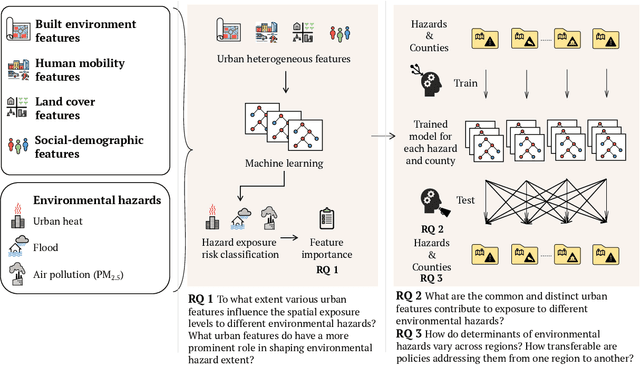
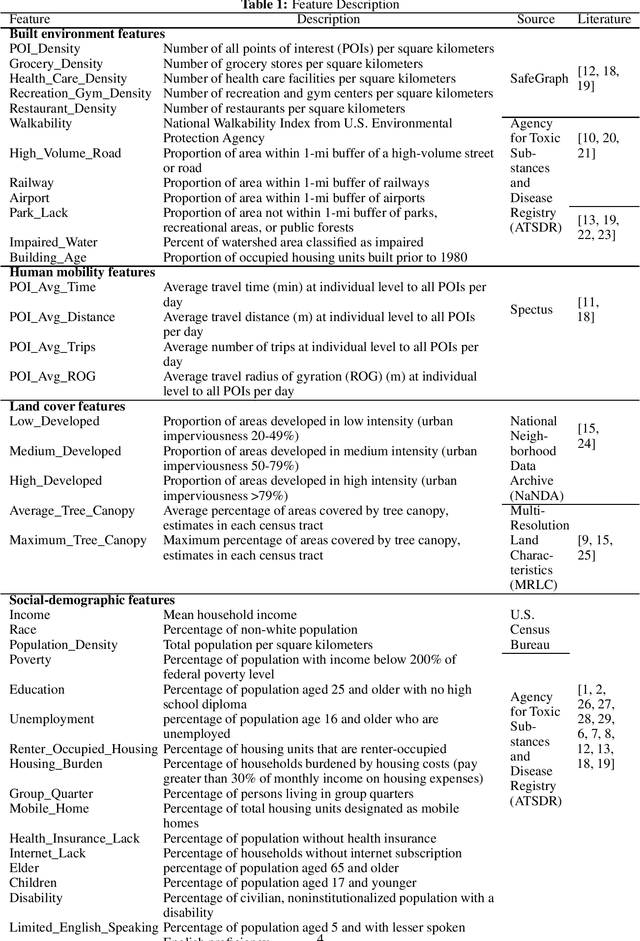
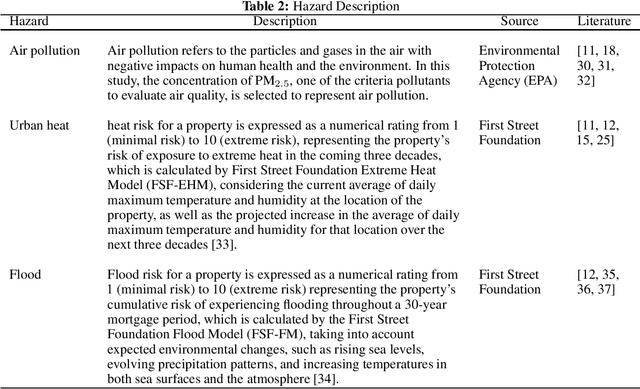
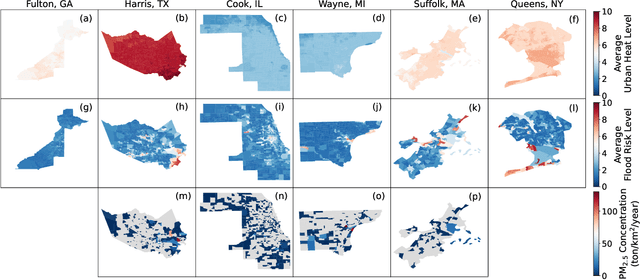
Abstract:Understanding the key factors shaping environmental hazard exposures and their associated environmental injustice issues is vital for formulating equitable policy measures. Traditional perspectives on environmental injustice have primarily focused on the socioeconomic dimensions, often overlooking the influence of heterogeneous urban characteristics. This limited view may obstruct a comprehensive understanding of the complex nature of environmental justice and its relationship with urban design features. To address this gap, this study creates an interpretable machine learning model to examine the effects of various urban features and their non-linear interactions to the exposure disparities of three primary hazards: air pollution, urban heat, and flooding. The analysis trains and tests models with data from six metropolitan counties in the United States using Random Forest and XGBoost. The performance is used to measure the extent to which variations of urban features shape disparities in environmental hazard levels. In addition, the analysis of feature importance reveals features related to social-demographic characteristics as the most prominent urban features that shape hazard extent. Features related to infrastructure distribution and land cover are relatively important for urban heat and air pollution exposure respectively. Moreover, we evaluate the models' transferability across different regions and hazards. The results highlight limited transferability, underscoring the intricate differences among hazards and regions and the way in which urban features shape hazard exposures. The insights gleaned from this study offer fresh perspectives on the relationship among urban features and their interplay with environmental hazard exposure disparities, informing the development of more integrated urban design policies to enhance social equity and environmental injustice issues.
ELEV-VISION: Automated Lowest Floor Elevation Estimation from Segmenting Street View Images
Jun 05, 2023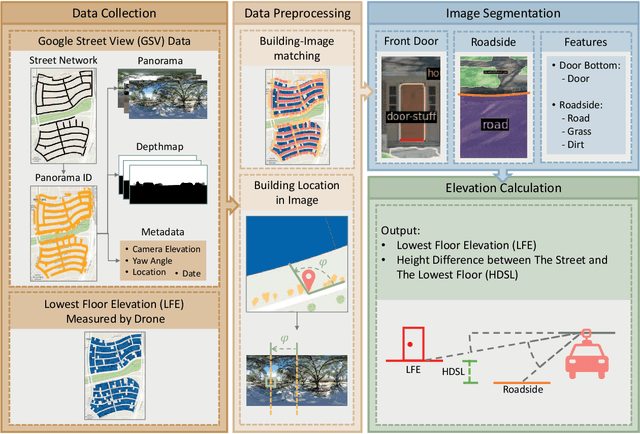
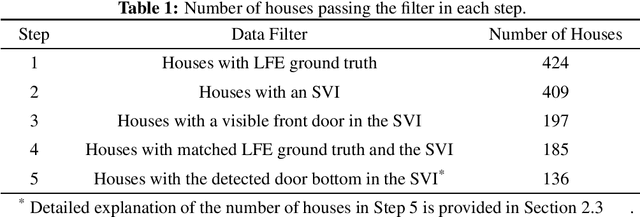
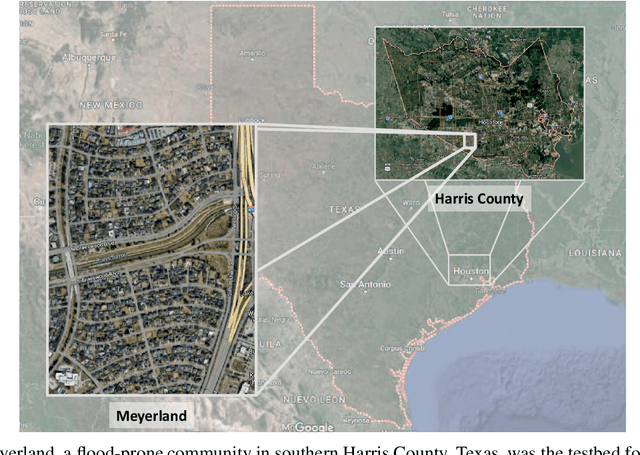

Abstract:We propose an automated lowest floor elevation (LFE) estimation algorithm based on computer vision techniques to leverage the latent information in street view images. Flood depth-damage models use a combination of LFE and flood depth for determining flood risk and extent of damage to properties. We used image segmentation for detecting door bottoms and roadside edges from Google Street View images. The characteristic of equirectangular projection with constant spacing representation of horizontal and vertical angles allows extraction of the pitch angle from the camera to the door bottom. The depth from the camera to the door bottom was obtained from the depthmap paired with the Google Street View image. LFEs were calculated from the pitch angle and the depth. The testbed for application of the proposed method is Meyerland (Harris County, Texas). The results show that the proposed method achieved mean absolute error of 0.190 m (1.18 %) in estimating LFE. The height difference between the street and the lowest floor (HDSL) was estimated to provide information for flood damage estimation. The proposed automatic LFE estimation algorithm using Street View images and image segmentation provides a rapid and cost-effective method for LFE estimation compared with the surveys using total station theodolite and unmanned aerial systems. By obtaining more accurate and up-to-date LFE data using the proposed method, city planners, emergency planners and insurance companies could make a more precise estimation of flood damage.
 Add to Chrome
Add to Chrome Add to Firefox
Add to Firefox Add to Edge
Add to Edge